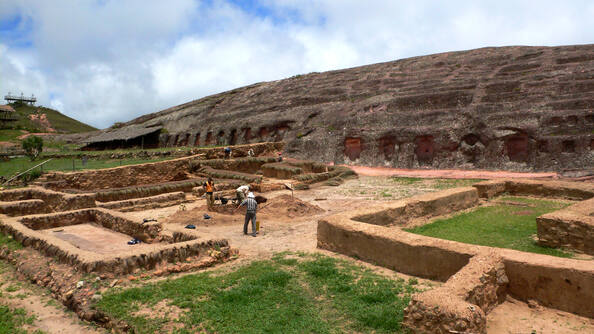Fuerte de Samaipata
Fuerte de Samaipata
The archaeological site of Samaipata consists of two parts: the hill with its many carvings, believed to have been the ceremonial centre of the old town (14th–16th centuries), and the area to the south of the hill, which formed the administrative and residential district. The huge sculptured rock, dominating the town below, is a unique testimony to pre-Hispanic traditions and beliefs, and has no parallel anywhere in the Americas.
Description is available under license CC-BY-SA IGO 3.0
Fort de Samaipata
Le site archéologique de Samaipata comprend deux éléments : la colline, qui, avec ses nombreuses gravures, semble avoir constitué le centre cérémoniel de la ville ancienne (XIVe-XVIe siècle), et la zone au sud de la colline, qui formait le quartier administratif et résidentiel. L’énorme rocher sculpté de Samaipata, qui domine la ville située en contrebas, constitue un témoignage unique des traditions et croyances préhispaniques, sans égal sur tout le continent américain.
Description is available under license CC-BY-SA IGO 3.0
قلعة ساماي باتا
يتألف موقع ساماي باتا الأثري من عنصرين أساسيين هما: التلّة التي يبدو من خلال نقوشاتها العديدة أنّها شكّلت المركز الرسمي للمدينة القديمة (بين القرن الرابع عشر والسادس عشر)، والمنطقة الواقعة جنوب التلة والتي كانت تمثّل الحي الإداري والسكني للمدينة. وتُعدّ هذه الصخرة الضخمة المحفورة التي تطلّ على المدينة الجاثمة في أسفلها خير شهادة على التقاليد والمعتقدات الشائعة ما قبل الغزو الإسباني والتي لا مثيل في كافة أرجاء القارة الأميركية.
source: UNESCO/CPE
Description is available under license CC-BY-SA IGO 3.0
萨迈帕塔考古遗址
萨迈帕塔考古遗址由两部分组成:一部分是一座小山丘,山上有许多雕刻,被认为是14世纪到16世纪当地古镇举行仪式的中心;另一部分位于小山丘南面,是当时的行政和住宅区。一块巨型雕刻石块占据了小镇下方的大部分面积,是古拉丁美洲文化传统和信仰的唯一见证,在美洲再无可与之媲美之石刻。
source: UNESCO/CPE
Description is available under license CC-BY-SA IGO 3.0
Археологический памятник Фуэрте-де-Самайпата
Археологический памятник Самайпата состоит из двух частей: холма с многочисленными наскальными резными орнаментами, вероятно, бывшим церемониальным центром древнего города (XIV-XVI вв.), и территории к югу от холма, представлявшей административный и жилой район. Огромный холм, возвышающийся над расположенными внизу руинами, служит редчайшим напоминанием о доиспанских традициях и верованиях, не имеющим аналогов в Америке.
source: UNESCO/CPE
Description is available under license CC-BY-SA IGO 3.0
Fuerte de Samaipata
El sitio arqueológico de Samaipata consta de dos partes: el cerro, que posee numerosos grabados rupestres y fue probablemente el centro ceremonial de la antigua ciudad durante los siglos XIV a XVI; y la zona situada al sur del cerro, donde se hallaban los edificios administrativos y las viviendas. La gigantesca roca esculpida que domina la ciudad desde lo alto es un testimonio, único en su género, de las tradiciones y creencias prehispí¡nicas y no tiene parangón en toda América.
source: UNESCO/CPE
Description is available under license CC-BY-SA IGO 3.0
サマイパタの砦
ボリビア東部の中心地サンタ・クルス市より20kmの小村。村から5km離れた山の上にはプレ・インカの遺跡が残されている。この考古学的遺跡は二つの部分からなっている。それは古代都市(14~16世紀)の宗教的儀式の中心と考えられる多数の彫刻物を有する丘と、丘の南方の政治と居住区域である。また、下方の市街にある多数の岩面画は、先スペイン時代の伝統と信仰の独自の例証であり、南アメリカ各地において類似するものは他に存在しない。source: NFUAJ
Fuerte de Samaipata
Het archeologische gebied van Samaipata bestaat uit twee delen: de heuvel met zijn vele kervingen - dit zou het ceremoniële centrum van de oude stad in de 14e tot 16e eeuw zijn geweest - en het terrein ten zuiden van de heuvel dat het bestuurlijke en woongebied vormden. Het gebied werd 300 na Christus gebruikt als een ritueel en residentieel centrum door mensen van de Mojocoyas cultuur. Rond deze tijd werd ook begonnen met de vorming van de enorme gebeeldhouwde rots die de stad eronder domineert. De rots getuigt van pre-Spaanse tradities en overtuigingen en in de Amerika's is er geen parallel van te vinden.
Source: unesco.nl
